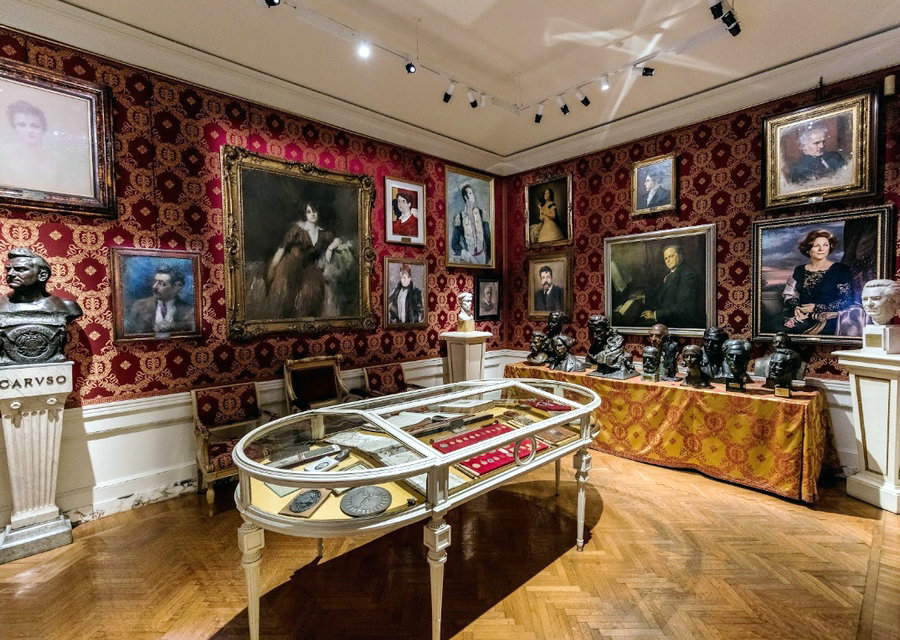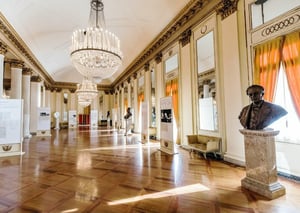Between the 1800s and 1900s, Europe experienced a time of profound changes. Not even the Teatro alla Scala can escape this era of upheavals. Rooms 7 and 8 are dedicated precisely to the protagonists of this turbulent period.
Arturo Toscanini, the reforming conductor of the modern Scala. Eleonora Duse, restless protagonist of the Italian theater. Giacomo Puccini, the new man of Italian opera, who for La Scala writes Edgar, Madama Butterfly, Turandot. To finally reach Maria Callas, an unforgettable voice of the 1900s.
The seventh room:
theatre in the early XX century
In the seventh room, there is a bust of the actress Eleonora Duse. She was born in Vigevano, near Pavia, the daughter of a couple of actors who originally camefrom what is now the Veneto region. She débuted at the age of five as Cosette in Victor Hugo’s Les Misérables.
Her life was spent travelling with the great acting companies of Italy, Europe and America. She was gradually attracted towards the naturalist theatre of D’Annunzio and Ibsen. Admired by the authors for the intensity of her performance, she had long and tormented relationships with Arrigo Boito and Gabriele D’Annunzio. In the same room, you will find a portrait of Amilcare Ponchielli, the author of La Gioconda, and the sketches for some stage curtains.
The eight room:
Verdi, Boito and the stars of the XX century
The eight room of the museum is dedicated to the late 19th and 20th centuries. Lodovico Pogliaghi and Adolf Hohenstein depicted the final hours of Verdi, who passed away on 27th January 1901. Three generations of the Ricordi family who had published the composer’s work are also represented here: Giovanni, Tito and his son Giulio.
A large space is devoted to a long line of stars: Rosina Storchio, Claudia Muzio, Francesco Tamagno, Enrico Caruso, Aureliano Pertile, Tancredi Pasero, Maria Callas, Renata Tebaldi, Giuseppe Di Stefano, Mario Del Monaco, Franco Corelli and Leyla Gencer. Then there is a tribute to Rudolf Nureyev and one to Giorgio Strehler.
The large showcase in the centre of the room contains numerous mementos and batons belonging to conductors, as well as the anastatic copy of the score of Verdi’s Requiem
The current construction, dating back to 1831, was designed by Giacomo Tazzini and replaced the so-called “Casino dei Nobili”, built according to Piermarini’s design at the same time as La Scala. This complex is still known today as “Casino Ricordi”. Indeed, the famous music publishing house was located here for many years.
Arrigo Boito, here portrayed by Arturo Rietti, was one of the undisputed leaders of musical life in the second half of the nineteenth century. He was a literary figure and member of the Italian movement “scapigliatura”. He had studied in Paris and had acquired a refined and international culture. He is remembered mainly as a librettist. Still, he was also an important musician and composer of Mefistofele and Nerone.
Boito was also one of the founders of this Museum and put his exceptional talents to work bring it to fruition. His brother, Camillo, was the architect who designed the Retirement Home for Musicians in Milan, subsidised and maintained for years by Giuseppe Verdi
Artworks
Arturo Rietti, portrait of Arturo Toscanini
Arturo Rietti, portrait of Giacomo Puccini
Eduard Kaulbach, portrait of Eleonora Duse
Filippo Cifariello, bust of Enrico Caruso
Ulisse Sartini, portrait of Maria Callas
Ulisse Sartini, portrait of Renata Tebaldi
A Troubridge bust of Vaslav Nijinsky
The sixth room:
Verdis memorabilia
The sixth room of the museum contains objects that were originally part of the Sambon collection. Busts and statuettes made of bisque porcelain depict famous musicians or theatrical characters.
In the room are also kept some memorabilia some pieces of memorabilia related to Verdi: his death mask; a lock of his hair; a cast of his right hand; his portable writing desk complete with an inkwell, pens, a letter-holder, a pack of cards and a French-Italian dictionary. These objects were all found in Verdi’s room at the Grand Hotel et de Milan when he died.
The fifth room:
Pasta, Patti, Rossini and Wagner
In the fifth room of the museum you can find two portraits of Adelina Patti, a singer and actress who flourished in the second half of the 19th century. She has been the prima donna at La Scala in the 1877 and 1878 seasons. In this room, you will also find Marocchetti’s famous bronze bust of Rossini, a portrait of Gaetano Donizetti and another of Giuditta Pasta, the first interpreter of Norma.
In her portrait by Gioacchino Giuseppe Serangeli. she is seen holding the score for Rossini’s Tancredi open at the page of the famous aria “Di tanti palpiti”, while in the painting by Gérard she is depicted in her costume as Norma. Another bronze bust, a copy by Lorenz Von Gedon (stored in Monaco), depicts Richard Wagner.
One of his letters to Arrigo Boito is held in the archive and dates from the Italian première of Lohengrin in Bologna. The composer reveals a very important hidden detail: “I don’t know if it was a demon or a genius of the kind which takes hold of us in those decisive moments, however, I was lying sleepless in a hotel in La Spezia when the inspiration for the music for Das Rheingold came to me”.
The room is completed by two showcases containing some small musical instruments, including a curious crystal flute, and some medals belonging to artistes and composers.
Teatro alla Scala Museum
The Museum is actually located between via Filodrammatici and Piazza della Scala, in a lateral wing of the historic building designed by Giuseppe Piermarini.
The current construction, dating back to 1831, was designed by Giacomo Tazzini and replaced the so-called “Casino dei Nobili”, built according to Piermarini’s design at the same time as La Scala. This complex is still known today as “Casino Ricordi”. Indeed, the famous music publishing house was located here for many years.
The first nucleus of the museum was established in 1911 with the purchase at a Parisian auction of the private collection of the Parisian antiquarian Giulio Sambon , a great fan of theater . The purchase was made possible thanks to a public subscription and a government allocation. The subscription fee was 5,000 lire at the time, a considerable figure, which is close to 15,000 euros today. The collection was intended to document the history of the show from antiquity to modernity, initially without a relationship with the specific activity of the Teatro alla Scala. The museum was officially inaugurated on March 8, 1913.
In the following years many donations and acquisitions were added to the initial nucleus of the collection. During the Second World War the collections were moved to safe places for safekeeping and at the end of the war, after the reconstruction, the museum was rearranged by Fernanda Wittgens . The exhibition area of the museum consists of fourteen rooms and exhibits marble busts and portraits of numerous composers , conductors and artists of the European musical field of the last two centuries, ancient musical instruments. Some paintings depict the Teatro alla Scala.







